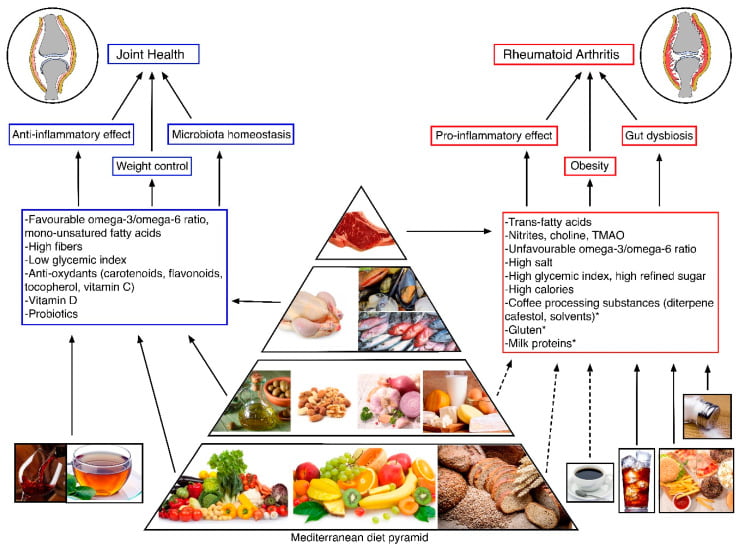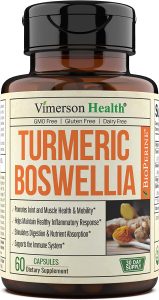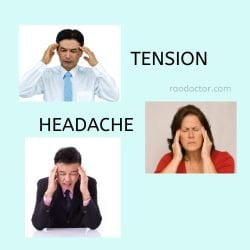Diet in RA-What to Eat, What Not to Eat, When to Eat and Which Food Gives the Maximum Benefit in Rheumatoid Arthritis
When we speak about diet, we mean the food or food items that we eat to nourish our body. And, when we are talking about diet in rheumatoid arthritis or any other illness for that matter, we talk about the foods that bring us good health or that which causes illness. In medical terms they are either anti-inflammatory or pro-inflammatory.
Reducing the fat intake, increasing the protein and carbohydrate intake, including fruits and vegetables in the diet — these are some of the basic recommendations for a healthy diet.
Rheumatoid arthritis is an autoimmune disease that causes chronic inflammation in the joints. There are some diseases of the gut caused by eating certain foods that trigger an immune response. These foods can also trigger immune response in RA. As a result of this inflammation, pain and limitation of movement occur.
To manage this condition, you need to alter your diet and lifestyle habits. A balanced diet with sufficient nutrients is necessary for maintaining good health. Moreover, certain foods can reduce inflammation and ease symptoms of rheumatoid arthritis. In this article, we will explore what you should eat or not eat if you have RA and how it can help you get relief from joint pain faster.
My previous two articles discussed how Fomentation and Massage helps relieve discomfort of RA. If you have not already read it, you can read it here-
Table of Contents
Why does eating the right food matter in RA?
Rheumatoid arthritis is an inflammatory disease of the joints, particularly, the synovial membrane of the joint, known as synovitis. During a flareup, the inflammatory markers such as C-reactive protein or the CRP rise due to some chemicals called free radicals or oxidants that are circulating in the body. To overcome this, we need something called antioxidants. Some foods like fruits, vegetables and spices contain these antioxidants.
There are some foods that have the ability to reduce these chemicals and reverse inflammation. So, eating the right type of food, especially those that contain antioxidants, Omega3 fatty acids, naturally occurring vitamins and minerals, go a long way in treating RA.
What is a healthy diet in rheumatoid arthritis?
To maintain a healthy diet, it is important to eat a variety of foods from all the food groups, i.e., vegetables, fruits, grains, protein, dairy, and fats. As prescribed by an expert, you can alter your diet to avoid certain foods that may trigger RA symptoms.
Avoid foods with gluten, dairy, and high-fat content. Include foods rich in fiber, vitamins, and minerals that can benefit your health. A healthy diet can help you lower your risk of chronic diseases.
One of the most important recommendations is to decrease [but not entirely do away with it] the amount of fat in your diet and increase your intake of fiber. Fiber0us diet can help lower your risk of heart disease, diabetes, and some cancers. It can also help you lose weight and lower your cholesterol.
A diet rich in fruits and vegetables is another important factor for good health. They are rich in vitamins, minerals, and fiber, and can help protect you from diseases, including cancer.
How does a diet Influence symptom in Rheumatoid Arthritis?
Have a look at the picture below released by NCBI-NIH [link given below]. It shows how a healthy joint appears in the beginning when there has been a balanced diet. Further on, after eating foods that are not gut-healthy, changes start taking place in the body that affect our joints as we age. And, if one is suffering from RA, these symptoms worsen day-by-day.

Foods to eat in RA
Here are some foods to include in your diet if you have RA.-
- Whole Grains: Whole grains are a good source of fibre, vitamins, and minerals. You can find whole grain breads, oats, rice, and pasta in the market. Include them as a part of your daily diet to prevent chronic diseases. – Increase
- Fruits and vegetables: Fruits and vegetables are low in fat and calories, rich in fibre, vitamins, and minerals. They can lower your risk of heart disease and certain cancers. – Increase
- Herbs and Spices- such as garlic, ginger, cinnamon, curcumin, black pepper, basil, parsley, etc.- Increase
- Dairy Products: Dairy products like milk and cheese are rich in calcium and protein. They are good for your bones and teeth. In some people, they can cause lactose intolerance and problems of the gut by changing the gut friendly bacteria leading to gut inflammation and flareup in RA. – Use in Moderation
- Legumes: Legumes are good sources of fiber, protein, and minerals. They are the best substitute for meat. – Increase
- Nuts and seeds: They are a good source of protein, fiber, and minerals. They can be eaten as snacks between meals. – Increase
- Fish: Oily fish like salmon, mackerel, herring, and sardines are rich in omega-3 fatty acids, protein, and minerals. – Increase
- Vegetable oils: Virgin olive oil, sunflower oil, and canola oil are rich in monounsaturated fats. – Use in Moderation
- Red meat: Red meat is rich in protein and minerals. Most of the patients of RA are anemic. Red meat can help in improving anemia. It is low in fibre and has high saturated fat content- Reduce
Vegetables that help reduce RA symptoms
Vegetables are rich in vitamins, minerals, and fibre. They are low in fat and cholesterol. Here are some vegetables that can help reduce RA symptoms-
- Carrots 🥕 : Carrots are rich in beta-carotene, vitamin A, and potassium. Vitamin A can reduce the severity of arthritis.
- Cauliflower or Broccoli 🥦 : It is rich in vitamin C and fibre. Vitamin C reduces the severity of joint pain.
- Cucumber 🥒. It is rich in vitamin C, fibre, and potassium. It can reduce the severity of joint pain and reduce inflammation in the joints.
- Spinach 🍃 .. Spinach is rich in vitamin A and C. It can reduce the severity of joint pain. Here is one link to a video that shows a quick recipe of spinach that can help in RA.
- Tomatoes 🍅: It is rich in vitamin C and lycopene. They can reduce the severity of joint pain and reduce the risk of heart disease as well.
Can fats like ghee help reduce inflammation in RA?
Ghee is an Indian cooking fat made from clarified butter. It is rich in nutrients like
- Vitamin E, calcium, and selenium that can reduce the severity of joint pain caused by RA.
- Butyric acid, which reduces the symptoms of RA.
You can add ghee to your diet to relieve joint pain. It can be used as a dressing on salads, vegetables, and rice.
Ghee can be used instead of butter or oil in desserts. It can also be used to sauté vegetables. A word of caution- ghee is rich in calories, so use it in moderation. One tablespoon (approximately 15 gm) contains-
- 13 gm fat (split as below)
- 8 gm saturated fats
- 4 gm MUFA
- 5 gm PUFA
- About 112 calories
- Vitamins A, E and K.
For ages, Ayurvedic physicians in India have been using ghee to formulate their medicines. Even today, the practicing physicians who prescribe some orthodox plant-based powders for treatment of RA advise it should be taken with a teaspoon of ghee.
Here is an article that will help you understand all the benefits of eating Ghee.
Foods to avoid in RA
There are certain foods that trigger RA symptoms and should be avoided in a healthy diet. These include –
- Gluten: Gluten-rich foods like wheat, barley, rye, etc., contain prolamins that can trigger RA symptoms.
- High-fat foods: High-fat foods like oil, butter, cheese, and meat can increase the risk of heart disease and diabetes.
- Excess Salt: Excess salt can increase the risk of hypertension and heart diseases.
- Soda and sugary drinks: Regular soda and sugary drinks can cause flareups in RA by causing bone pain.
- Food rich in preservatives: Food rich in preservatives can increase the risk of certain cancers.
- Caffeine: Decaffeinated coffee intake can increase or worsen the pain in RA.
Red meat, alcohol, and soft drinks are examples of foods reported to worsen symptoms, whereas fish and berries are reported to improve symptoms (11, 12). There are few studies investigating whole diets, but beneficial effects on disease activity have been noted in intervention studies with a Mediterranean diet (13) as well as with fasting followed by a vegetarian diet (14) and gluten-free vegan diet (15)
Source-NICB-NIH
Which protein causes flareups in RA?
There are certain proteins that can cause flareups in RA. Here again, these may benefit some people but may cause flareups in some, which are not yet proven by scientific research-
- Dairy: Dairy products contain lactose, which can trigger RA symptoms. You can replace dairy products with coconut milk, almond milk, and soy milk.
- Nuts: Nuts are rich in protein, fibre, and minerals. Sometimes, they can cause an allergic reaction in some people and can trigger RA symptoms.
- Soy: Soy is a good source of protein, fibre, and minerals, but It can worsen the symptoms of RA if you are allergic to it.
- Fish: Fish, especially shellfish, sometimes contain elevated levels of mercury, which can worsen the symptoms of RA.
- Red meat: red meat contains elevated levels of iron, which can worsen the symptoms of RA.
When and what to eat during flare-ups?
It depends on what and how you implement your diet when you know which food items increase or decrease RA symptoms. So, learning from these events, judiciously and diligently use the food items mentioned in this article, as and when you have a flareup of RA.
In my previous articles, I had written on the importance of eating fruits. You can read the articles here- Fruits 1 and Fruits 2 for your quick reference.
When you experience a flare-up, you can eat these foods to reduce pain and inflammation.
- Banana: Banana is rich in potassium, which can reduce muscle and joint pain.
- Coconut water: Coconut water is rich in potassium [helps as given above].
- Papaya: Papaya is rich in vitamin C, an antioxidant that removes inflammation causing chemicals.
- Pomegranate: Pomegranate is rich in vitamin C [same as in 3]
- Apple: Apple and its seeds are rich in vitamin C [same as in 3]
Other than the above-mentioned items, these are some more things that help reduce inflammation-
Water: Water can prevent dehydration, which can reduce joint pain. [Read this article on how dehydration affects RA]
Oats: Oats are rich in beta-glucan, which can reduce joint pain.
Raspberries: Raspberries are rich in vitamin C and fibre, which can reduce joint pain.
Useful resource:- 7 foods to improve joint health
Food supplements to reduce inflammation and ease pain in RA
According to Arthritis foundation, there are a few supplements that can help in overcoming pain and inflammation in RA. Here are they-
- Boswellia Serrata- this is the extract of the bark of Boswellia tree, especially found in India and that which is used as treatment in ayurvedic medications in India. It is sold as Shallaki capsules in India
- Turmeric or Curcumin supplements-reduces pain, stiffness, and inflammation in RA.
- Bromelain– found in pineapples and has both anti-inflammatory and pain-relieving properties.
- Fish oil– reduces inflammation and morning stiffness in RA.
- Ginger– the powder used as a spice in curries can help reduce pain and stiffness in RA.
These are some of the food items that are available as supplements as shown below-

![Diet in Rheumatoid Arthritis [RA]: 6 Facts To help you live A Healthy, Pain-free and Better life 2 Boswellia 3](https://raodoctor.com/wp-content/uploads/2022/06/boswellia-3-506x1024.jpg)

These products are available online on Amazon.com. You can easily get the details of these products by clicking the links of different countries as given below-
These supplements do not cure RA, but they are known to reduce pain and morning stiffness and should not be used as the first line of treatment. Of course, in the early stage of disease, they can slow down the progress or advancement of RA.
Disclosure–
The above shown products contain links in the images that are affiliate links, meaning that if you purchase any product using this link, the author gets a small commission without any extra cost to the purchaser [along with the displayed discount]. This helps me in maintaining this website and getting fresh content to you that comes absolutely free with it as and when it is published. Most of my pictures are designed on Canva Pro- click this link if you would like to get Canva Pro.
Conclusion
Rheumatoid arthritis is a chronic autoimmune disease that causes inflammation in joints. To manage this condition, you need to alter your diet and lifestyle habits. A healthy diet with sufficient nutrients is necessary for good health. Moreover, certain foods can reduce inflammation and ease symptoms of RA.
Finally, as I conclude this article, I would strongly recommend that you watch these two short videos from Arthritis Society, Canada, on What to Eat and How to Eat for arthritis in general:

![Diet in Rheumatoid Arthritis [RA]: 6 Facts To help you live A Healthy, Pain-free and Better life 1 What to eat and what not to in rheumatoid arthritis](https://raodoctor.com/wp-content/uploads/2022/07/DIET-IN-RA-250x141.jpg)



